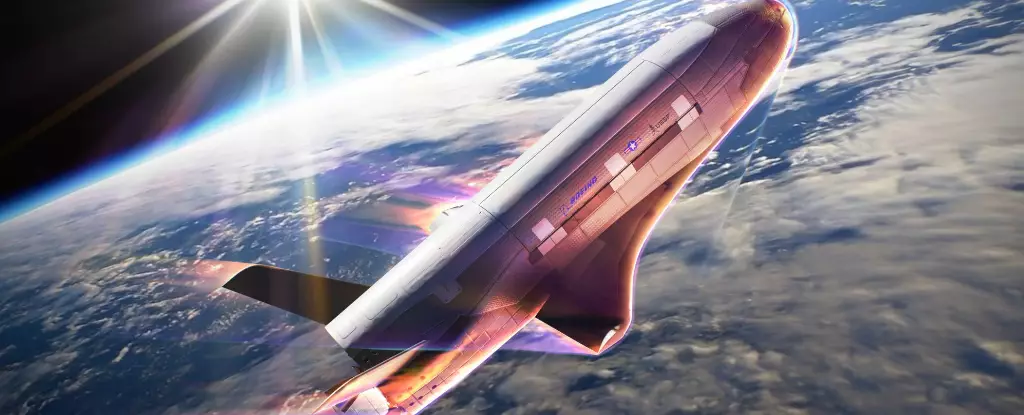The X-37B Orbital Test Vehicle (OTV) has captivated the imagination of space enthusiasts and security experts alike since its inaugural flight in 2011. Developed by Boeing and overseen by the United States Space Force (USSF), this remotely operated space plane has effectively blended advanced aerospace technology with military strategy. As the OTV embarks on its seventh mission—dubbed OTV-7—it continues to raise questions regarding both its capabilities and overarching objectives.
The X-37B is uniquely designed to operate in Low-Earth Orbit (LEO), ranging from 240 to 800 kilometers (150 to 500 miles) above the surface. This strategic position allows for experimentation and testing of reusable vehicle technologies crucial for long-term goals in space exploration and national defense. Launched on December 29, 2023, the OTV-7 mission has become particularly intriguing as it is now conducting experiments focused on space radiation effects and developing technologies related to Space Domain Awareness (SDA).
One of the defining features of this mission is the X-37B’s intent to execute a series of groundbreaking orbital alterations. By employing a method known as “aerobraking,” the spacecraft will glide through the upper layers of Earth’s atmosphere, effectively shedding speed and lowering its orbit while conserving fuel. This maneuver is indicative of innovative approaches to orbital mechanics, showcasing the OTV’s sophisticated engineering and potentially altering the dynamics of space operations.
The concept of aerobraking, while not new to space engineering, has never been performed by the X-37B until now. Historically, this technique has been employed in various capacities, including missions to Mars, where spacecraft like the Mars Global Surveyor and the Mars Reconnaissance Orbiter utilized similar strategies to adjust their orbits. Yet the application of this technique by the X-37B serves a dual purpose: to extend the mission’s operational life and to enhance its stealth capabilities as it navigates around Earth.
This maneuver could enable the X-37B to remain undetected by hostile nations, performing clandestine surveillance missions without revealing its position. The technology behind such operations not only streamlines fuel consumption but also adds a layer of strategic advantage by obfuscating the spacecraft’s trajectory. As former USAF Secretary Heather Wilson noted, this ability to execute unpredictable orbits drives adversaries into a state of uncertainty and heightened vigilance.
The strategic implications of the X-37B’s capabilities are profound. Its capacity for covert navigation could shape the future of military engagements in space, allowing for surveillance and other operations that remain below the radar of adversarial reconnaissance. As Jonathan McDowell, an expert in astrophysics, highlighted, the unpredictability of the X-37B’s orbit complicates tracking efforts for potential adversaries. Simple adjustments in timing alone could render traditional tracking methods ineffective, thus granting the USSF unparalleled strategic flexibility in space operations.
Beyond military effectiveness, the X-37B’s ongoing missions contribute to national security objectives and demonstrate the US Space Force’s commitment to innovation. The experiments conducted during the OTV-7 mission, including testing the effects of space radiation on biological materials—like the NASA-provided plant seeds—will pave the way for future exploratory missions.
As the X-37B continues its mission, it faces the long-term challenge of space debris. To ensure that its operations remain sustainable, the spacecraft is programmed to eject certain components in compliance with established standards aimed at reducing space litter. This not only underscores the responsible usage of outer space but also aligns with wider regulatory frameworks focused on mitigating environmental impacts in LEO.
In a broader perspective, the work conducted aboard the X-37B acts as a catalyst for policy discussions regarding space traffic management and debris mitigation. The lessons learned from the OTV missions may inform future endeavors, ensuring that the quest for strategic advantage does not come at the cost of a sustainable space environment.
The unveiling of the X-37B’s capabilities highlights a juncture where space exploration intersects with national security needs. As the OTV-7 mission progresses, its innovative maneuvers and experimental undertakings signal a revolutionary shift in how the United States conducts its activities in space. The ongoing efforts not only represent technological ingenuity but also establish a foundation for future endeavors that prioritize both exploration and security in an increasingly contested domain. The X-37B stands as a testament to the United States’ commitment to lead in the realm of space technology while maintaining vigilant preparedness in matters of national defense.

